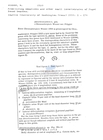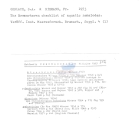RAS taxon details
Atrochromadora Wieser, 1959
marine
Wieser, W. (1959). Free-living marine nematodes IV. General part. <em>Acta Univ. lund (N. F. 2).</em> 55 (5): 1-111.
page(s): 110; note: The Genus Atrochromadora was first established in 1954 with the name Chromadoropsis. However, this name was preoccupied and so, in 1959, Wieser replaced the name Chromadoropsis with the name Atrochrom...
[details] Available for editors 
page(s): 110; note: The Genus Atrochromadora was first established in 1954 with the name Chromadoropsis. However, this name was preoccupied and so, in 1959, Wieser replaced the name Chromadoropsis with the name Atrochrom...
The Genus Atrochromadora was first established in 1954 with the name Chromadoropsis. However, this name was preoccupied and so, in 1959, Wieser replaced the name Chromadoropsis with the name Atrochromadora.
Nemys eds. (2025). Nemys: World Database of Nematodes. Atrochromadora Wieser, 1959. Accessed through: RAS (Eds.) (2025) Register of Antarctic Species at: https://ras.biodiversity.aq/aphia.php/aphia.php?p=taxdetails&id=2276 on 2025-07-18
RAS (Eds.) (2025). Register of Antarctic Species. Atrochromadora Wieser, 1959. Accessed at: https://ras.biodiversity.aq/aphia.php/www.pfeil-verlag.de/04biol/aphia.php?p=taxdetails&id=2276 on 2025-07-18
Date
action
by
2004-12-21 15:54:05Z
created
db_admin
2006-09-06 06:55:51Z
changed
Martinez, Olga
original description
Wieser, W. (1959). Free-living marine nematodes IV. General part. <em>Acta Univ. lund (N. F. 2).</em> 55 (5): 1-111.
page(s): 110; note: The Genus Atrochromadora was first established in 1954 with the name Chromadoropsis. However, this name was preoccupied and so, in 1959, Wieser replaced the name Chromadoropsis with the name Atrochrom...
[details] Available for editors 
basis of record Nemaslan: Biodiversity of Antarctic Nematodes (2004). (look up in IMIS) [details]
additional source Brunel, P., L. Bosse & G. Lamarche. (1998). Catalogue of the marine invertebrates of the estuary and Gulf of St. Lawrence. <em>Canadian Special Publication of Fisheries and Aquatic Sciences, 126.</em> 405 pp. (look up in IMIS) [details] Available for editors
additional source Neave, Sheffield Airey. (1939-1996). Nomenclator Zoologicus vol. 1-10 Online. <em>[Online Nomenclator Zoologicus at Checklistbank. Ubio link has gone].</em> , available online at https://www.checklistbank.org/dataset/126539/about [details]
additional source Various Authors (2000). Nematode filing cabinet of the Marine Biology Section Ugent - in combination with the NemasLan Ms-Access database (published on CD-Rom, 2000) (look up in IMIS) [details]
additional source Miljutin, D. M.; Gad, G.; Miljutina, M. M.; Mokievsky, V. O.; Fonseca-Genevois, V.; Esteves, A. M. (2010). The state of knowledge on deep-sea nematode taxonomy: how many valid species are known down there?. <em>Marine Biodiversity.</em> 40(3): 143-159., available online at https://doi.org/10.1007/s12526-010-0041-4 [details] Available for editors
additional source Venekey, V.; Fonseca-Genevois, V.; Santos, P. J. P. (2010). Biodiversity of free-living marine nematodes on the coast of Brazil: a review. <em>Zootaxa.</em> 2568: 39–66. [details] Available for editors
additional source Wieser, W. (1954). Free-living marine nematodes II. Chromadoroidea. <em>Acta Univ. lund (N.F.2).</em> 50 (16): 1-148. (look up in IMIS)
page(s): 68; note: Misapplication [details] Available for editors
additional source Integrated Taxonomic Information System (ITIS). , available online at http://www.itis.gov [details]
status source Wieser, W. (1959). Free-living nematodes and other small invertebrates of Puget Sound beaches. <em>University of Washington Publications in Biology (University of Washington Press, Seattle).</em> 19:1-179, figs. 1-109, pls. 1-96. (look up in IMIS) [details] Available for editors
ecology source Fonsêca-Genevois, V.da., P.J. Somerfield, M.H. Baeta-Neves, R. Coutinho & T. Moens. (2006). Colonization and early succession on artificial hard substrata by meiofauna. Marine Biology 148(5):1039-1050., available online at https://doi.org/10.1007/s00227-005-0145-8 [details] Available for editors
ecology source Raes, M.; De Troch, M.; Ndaro, S. G. M.; Muthumbi, A.; Guilini, K.; Vanreusel, A. (2007). The structuring role of microhabitat type in coral degradation zones: a case study with marine nematodes from Kenya and Zanzibar. <em>Coral Reefs.</em> 26 (1): 13-126. [details] Available for editors
page(s): 110; note: The Genus Atrochromadora was first established in 1954 with the name Chromadoropsis. However, this name was preoccupied and so, in 1959, Wieser replaced the name Chromadoropsis with the name Atrochrom...
The Genus Atrochromadora was first established in 1954 with the name Chromadoropsis. However, this name was preoccupied and so, in 1959, Wieser replaced the name Chromadoropsis with the name Atrochromadora.
basis of record Nemaslan: Biodiversity of Antarctic Nematodes (2004). (look up in IMIS) [details]
additional source Brunel, P., L. Bosse & G. Lamarche. (1998). Catalogue of the marine invertebrates of the estuary and Gulf of St. Lawrence. <em>Canadian Special Publication of Fisheries and Aquatic Sciences, 126.</em> 405 pp. (look up in IMIS) [details] Available for editors
additional source Neave, Sheffield Airey. (1939-1996). Nomenclator Zoologicus vol. 1-10 Online. <em>[Online Nomenclator Zoologicus at Checklistbank. Ubio link has gone].</em> , available online at https://www.checklistbank.org/dataset/126539/about [details]
additional source Various Authors (2000). Nematode filing cabinet of the Marine Biology Section Ugent - in combination with the NemasLan Ms-Access database (published on CD-Rom, 2000) (look up in IMIS) [details]
additional source Miljutin, D. M.; Gad, G.; Miljutina, M. M.; Mokievsky, V. O.; Fonseca-Genevois, V.; Esteves, A. M. (2010). The state of knowledge on deep-sea nematode taxonomy: how many valid species are known down there?. <em>Marine Biodiversity.</em> 40(3): 143-159., available online at https://doi.org/10.1007/s12526-010-0041-4 [details] Available for editors
additional source Venekey, V.; Fonseca-Genevois, V.; Santos, P. J. P. (2010). Biodiversity of free-living marine nematodes on the coast of Brazil: a review. <em>Zootaxa.</em> 2568: 39–66. [details] Available for editors
additional source Wieser, W. (1954). Free-living marine nematodes II. Chromadoroidea. <em>Acta Univ. lund (N.F.2).</em> 50 (16): 1-148. (look up in IMIS)
page(s): 68; note: Misapplication [details] Available for editors
additional source Integrated Taxonomic Information System (ITIS). , available online at http://www.itis.gov [details]
status source Wieser, W. (1959). Free-living nematodes and other small invertebrates of Puget Sound beaches. <em>University of Washington Publications in Biology (University of Washington Press, Seattle).</em> 19:1-179, figs. 1-109, pls. 1-96. (look up in IMIS) [details] Available for editors
ecology source Fonsêca-Genevois, V.da., P.J. Somerfield, M.H. Baeta-Neves, R. Coutinho & T. Moens. (2006). Colonization and early succession on artificial hard substrata by meiofauna. Marine Biology 148(5):1039-1050., available online at https://doi.org/10.1007/s00227-005-0145-8 [details] Available for editors
ecology source Raes, M.; De Troch, M.; Ndaro, S. G. M.; Muthumbi, A.; Guilini, K.; Vanreusel, A. (2007). The structuring role of microhabitat type in coral degradation zones: a case study with marine nematodes from Kenya and Zanzibar. <em>Coral Reefs.</em> 26 (1): 13-126. [details] Available for editors
 Present
Present  Inaccurate
Inaccurate  Introduced: alien
Introduced: alien  Containing type locality
Containing type locality



